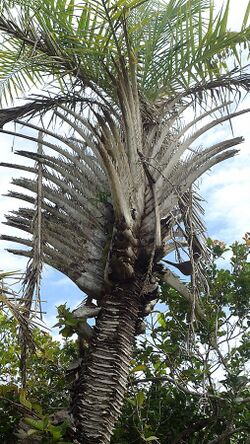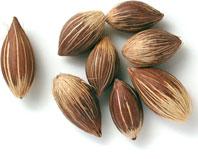Biology:Syagrus coronata
| Licuri palm[1] | |
|---|---|

| |
| Scientific classification | |
| Kingdom: | Plantae |
| Clade: | Tracheophytes |
| Clade: | Angiosperms |
| Clade: | Monocots |
| Clade: | Commelinids |
| Order: | Arecales |
| Family: | Arecaceae |
| Genus: | Syagrus |
| Species: | S. coronata
|
| Binomial name | |
| Syagrus coronata (Mart.) Becc.
| |
| Synonyms[3] | |
Syagrus coronata, commonly known as the ouricury palm,[4] aricuri palm, or licuri palm, is a species of palm tree that is native to eastern Brazil , ranging from the southern part of the state of Pernambuco, into the state of Bahia, south to the Jequitinhonha River in the state of Minas Gerais.[3][5][6] The tree can live for 30–150 years, though most only live for 8–10 years on average. It plays an important role in the diets of tropical seasonally dry forest animals.
Description
Syagrus coronata reaches 3 to 12 m (9.8 to 39.4 ft) tall with a crown of semi-plumose leaves.[7][8] The blooms are bright yellow, and the plants bear fruit for most of the year.[6]
Ecological importance
Licuri palm nuts are the main food source of Lear's macaw, making up around 95% of their diet.[9] These nuts can grow to be one inch (2.5 cm) in width.
Threats
The destruction of small seedlings by cattle poses a threat to the plants, primarily through the destruction of concentrated groves.[6] Those groves are vital to Lear's macaw.[6]
Uses
Syagrus coronata is the source of ouricury wax.
References
- ↑ "Plants Profile for Syagrus coronata (Ouricury palm)". http://plants.usda.gov/java/profile?symbol=SYCO.
- ↑ Botanic Gardens Conservation International (BGCI).; IUCN SSC Global Tree Specialist Group (2019). "Syagrus coronata". IUCN Red List of Threatened Species 2019: e.T148757800A148757802. doi:10.2305/IUCN.UK.2019-2.RLTS.T148757800A148757802.en. https://www.iucnredlist.org/species/148757800/148757802. Retrieved 18 November 2021.
- ↑ Jump up to: 3.0 3.1 "World Checklist of Selected Plant Families: Royal Botanic Gardens, Kew". http://apps.kew.org/wcsp/namedetail.do?name_id=198799.
- ↑ "Syagrus coronata". Natural Resources Conservation Service PLANTS Database. USDA. https://plants.usda.gov/core/profile?symbol=SYCO. Retrieved 4 December 2015.
- ↑ "Syagrus coronata (Licury Palm)". http://www.desert-tropicals.com/Palm/Syagrus_coronata.html.
- ↑ Jump up to: 6.0 6.1 6.2 6.3 Pittman, Tony (2000). "The Lear's Macaw". The Parrot Society UK. https://theparrotsocietyuk.org/site/index.php/conservation/projects/the-lears-macaw/.
- ↑ "Syagrus coronata". http://www.pacsoa.org.au/palms/Syagrus/coronata.html.
- ↑ Andrew Henderson; Gloria Galeano; Rodrigo Bernal (7 July 1997). Field Guide to the Palms of the Americas. Princeton University Press. p. 145. ISBN 978-0-691-01600-9. https://books.google.com/books?id=zZ2flHoGLtcC&pg=PA145. Retrieved 31 August 2012.
- ↑ "Lears Macaw". http://www.parrotsinternational.org/Species_Pages/Lears_photos_1.htm.
External links
Wikidata ☰ Q3285629 entry
 |



